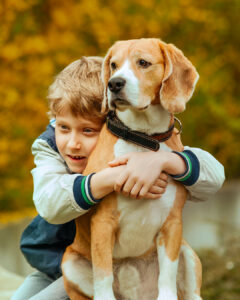Pets are an amazing way for autistic children to experience companionship, understand boundaries, share responsibilities, and reduce anxiety. Caring for an animal also provides opportunities to learn new skills — such as patience, empathy, communication — while also supporting an avenue of emotional expression.
 It’s important for all families to do some research on the right pet for them, but as caregivers to autistic children, it helps to consider our own limitations when deciding if our family should have a animal friend. Ask yourself these questions: Can my child properly handle a pet or interact with them appropriately? Am I prepared to help my child by coaching them and providing suitable supervision? Am I open to doing a pet trial to see if this will work?
It’s important for all families to do some research on the right pet for them, but as caregivers to autistic children, it helps to consider our own limitations when deciding if our family should have a animal friend. Ask yourself these questions: Can my child properly handle a pet or interact with them appropriately? Am I prepared to help my child by coaching them and providing suitable supervision? Am I open to doing a pet trial to see if this will work?
Once you’ve decided on a pet, it’s important to remember that bringing an animal into the home will always require an adjustment period. Every child is unique and every pet has unique preferences. Since sounds, smells, and touch may frighten pets away or cause frustration, the same may frighten an autistic child or cause a negative behavior. This foreknowledge is helpful with addressing possible aversions and sensitivities affecting the bond between an autistic child and their pet.
Here is how to handle challenges with pets if they arise:
- Assess the situation to determine what is causing the aversions. Why is the pet running away or why is the pet agitated? Why are they (the child and pet) uncomfortable around each other? Knowing the “why” helps with addressing and planning.
- Address the negative behavior with empathy. When your child is not nice to animals, acknowledge the situation by validating how your child is feeling in that moment. This can be done by saying something like, “I know you’re frustrated at the dog for being too loud. That must feel really frustrating for you.” Then you can talk about why it isn’t ok to behave in a negative way towards animals. You might even role-play positive ways to show affection for the animal instead of engaging in negative behavior towards them.
- Use social stories to help model appropriate behavior for your child. Here is a social narrative from ASNC that may be helpful.
- Establish rules and appropriate boundaries for your child.
It’s important to be patient and know that bonds between pets and children are not always instant. With the right accommodations, autistic children can learn how to safely care for an animal while benefiting from the unconditional acceptance and love their new pet provides.
Now, let’s find an adoptable pet in your area!
Tags: autism, autism anxiety, autism awareness, autism behavior, autism communication, new pets, pets Go back

